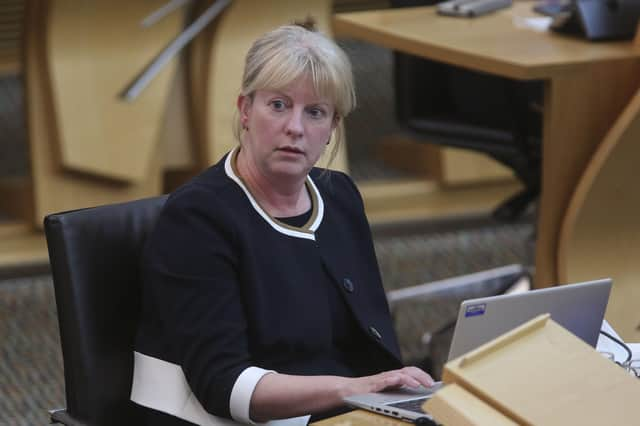Transgender reform and Scottish independence: As SNP stokes politics of identity and division, ordinary women's voices are not being heard – Susan Dalgety


We were both young politicians back then. She was a rising star in the SNP, and I was one of a generation of angry young Labour women, many of whom went on to make a big impact in Holyrood. Women like Johann Lamont, Sarah Boyack and Margaret Curran.
We were angry because Scotland, and in particular its political class, was dominated by men, from top to bottom. We saw devolution as a way of breaking out of the sexist culture that had infected our nation for centuries. Women were to be our country’s future.
Advertisement
Hide AdAdvertisement
Hide AdBut back to Dublin. Shona and I were the only two people from Scotland invited to join a carefully selected gathering of young politicians (all men) from Northern Ireland and the Republic. The weekend was an opportunity to learn from each other about governing by consent, in particular the role of political leaders.
I had largely forgotten the conference until a few days ago when I found myself sitting only a few feet away from my erstwhile roommate in a parliamentary committee room.
Her career has blossomed in the decades since. She is now the Cabinet Secretary for Social Justice, and a close associate of the First Minister. As one of Scotland’s political leaders, she is charged with the onerous responsibility of guiding our divided nation through these troubled times.
It is her job to steer the controversial Gender Recognition Reform Bill through parliament and on Tuesday she was giving evidence to the Equalities, Human Rights and Civil Justice committee, who are scrutinising the bill. I was there to report on its progress.
Five years ago, when the Scottish Government first mooted its plans to allow transgender people to change their legal sex by simple declaration, there was little opposition. But in the years since, a full-blown culture war has erupted, as women have realised the implications of self-ID for their hard-won rights, on everything from single-sex spaces to data collection.
The government has done itself no favours as the battle has intensified. The First Minister has dismissed women’s views as “not valid”. Women have been arrested for the ‘hate crime’ of tying suffragette ribbons round a tree.
And the bill itself appears to have been heavily influenced by government-funded groups such as the Equality Network, with little to no input sought from experts with views different from those of trans campaigners.
As a result, the bill leaves many questions unanswered, in particular the impact of significantly extending the ability to change legal sex from a tiny number of people – 30 a year at present according to Shona Robison – to an unknown number who want to live in their new “acquired gender.”
Advertisement
Hide AdAdvertisement
Hide AdThe trans movement has changed almost beyond recognition since 2004, when Labour introduced the Gender Recognition Act. Its primary aim was to make life – and marriage – easier for a small number of transsexuals, largely men who lived their life as women.
Today, there are far more people who claim to have a different gender from their birth sex, from teenage girls who bind their budding breasts because they think they are male, to twentysomethings who insist they are non-binary, neither male or female.
Giving evidence on Tuesday, Robison did little to answer growing concerns around the bill. She batted away questions about its impact on women whose faith does not allow them to share intimate spaces, such as changing rooms, with male-bodied people.
She pointed to other countries which have already introduced self-ID, such as Malta (incidentally, where abortion is illegal) as proof that there would be no problems in women’s prisons or the collection of data. She, and her officials, seemed uncertain about the cross-border issues the bill throws up, including the legitimacy of new birth certificates issued in Scotland.
And while she insisted she had thought long and hard about whether to reduce to 16 the age at which a person can change their legal sex, she decided that, on balance, it was the right thing to do.
Even a silent protest by some women in the public gallery – who revealed t-shirts bearing the legend “Nicola Sturgeon: Destroyer of Women’s Rights” – did not put Robison off her stride. “Thank you, Cabinet Secretary,” said her cheerleader, Karen Adam MSP, towards the end of the session, adding that all concerns have now been “debunked”.
Three hours after Robison finished defending her bill, Sturgeon announced her cunning plan for a second referendum on whether Scotland should leave the UK. There was an eerie similarity.
The Gender Recognition Reform Bill and the SNP’s referendum plans are full of holes. The draft referendum bill is already with the Supreme Court for a ruling on its legality. The gender bill, once enacted, is likely to end up there.
Advertisement
Hide AdAdvertisement
Hide AdBoth are about identity and have divided the country. Neither address the very real challenges all of us face daily, from rampant inflation to failing public services. And, for better or worse, both will shape Sturgeon’s legacy.
As Robison swept out of the committee room on Tuesday, I remembered a moment from Dublin 30 years ago, when she and I challenged a room full of men. “Where are the women?” we asked. “You can’t build a better country without women.”
Today, it seems that Robison and Sturgeon, the most powerful women in the land, are convinced they can create a new Scotland while ignoring the urgent voices of ordinary women. How times have changed.
Comments
Want to join the conversation? Please or to comment on this article.
